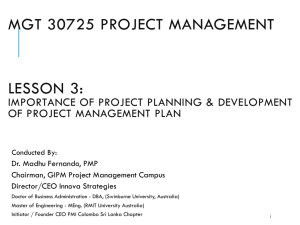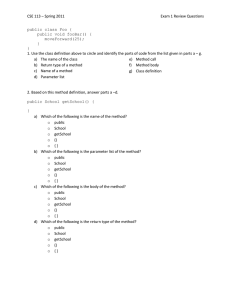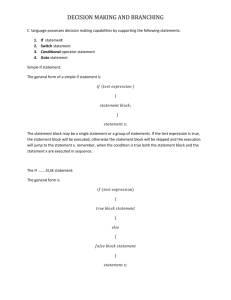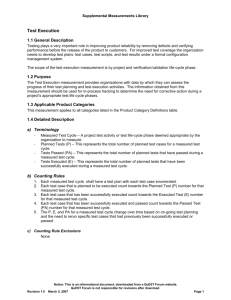CSE115 Introduction to Computer Science for Majors I Spring 2008
advertisement
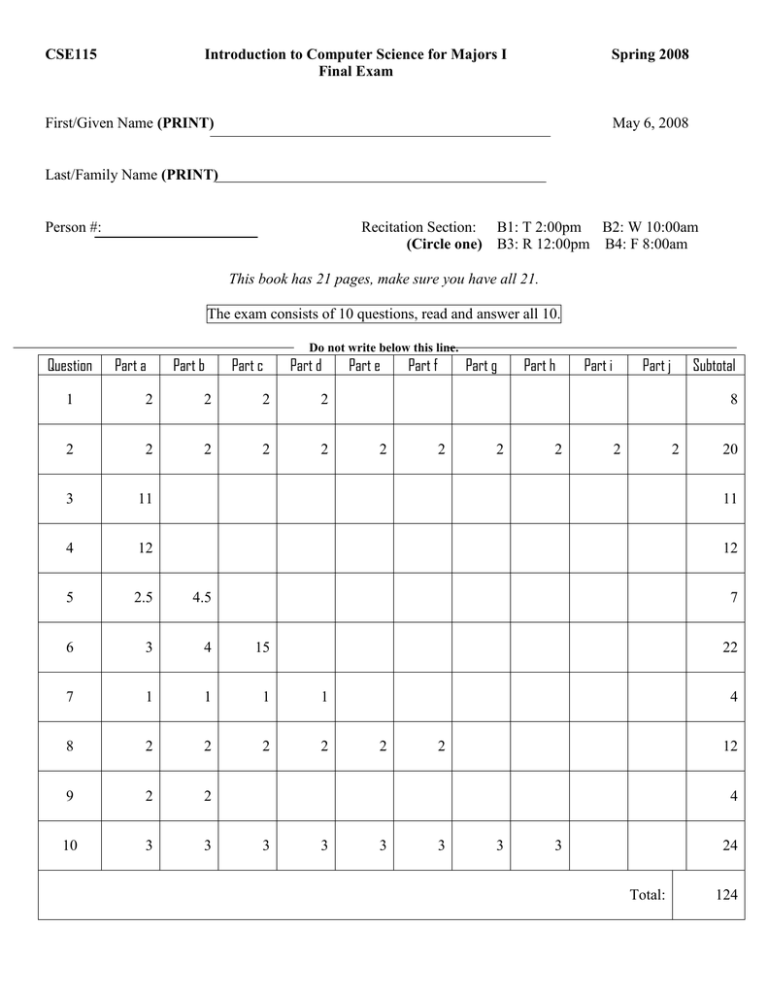
CSE115
Introduction to Computer Science for Majors I
Final Exam
Spring 2008
First/Given Name (PRINT)
May 6, 2008
Last/Family Name (PRINT)
Person #:
Recitation Section: B1: T 2:00pm B2: W 10:00am
(Circle one) B3: R 12:00pm B4: F 8:00am
This book has 21 pages, make sure you have all 21.
The exam consists of 10 questions, read and answer all 10.
Do not write below this line.
Question
Part a
Part b
Part c
Part d
Part e
Part f
Part g
Part h
Part i
Part j
Subtotal
1
2
2
2
2
8
2
2
2
2
2
3
11
11
4
12
12
5
2.5
4.5
6
3
4
15
7
1
1
1
1
8
2
2
2
2
9
2
2
10
3
3
2
2
2
2
2
2
20
7
22
4
2
2
12
4
3
3
3
3
3
3
24
Total:
124
CSE 115 Spring 2008
Final Exam
Page 2
Question 1
[8 points]
Fill in the code for the class named ExamGenerator as specified by parts a-c. Use the code you created to
answer part d.
Part a) Declare an instance variable of type Exam in the class. You can assume these two classes are in the
same package.
Part b) Inside the constructor, assign the instance variable a new instance of an Exam. (Note that the Exam
constructor takes no parameters)
Part c) Create a method named gradeExam that has a return type of void and takes no parameters. Inside the
method, call your instance variable’s grade method, which also takes no parameters.
public class ExamGenerator {
public ExamGenerator() {
}
}
Part d) In parts a & b, you created one of the relationships we studied so far this semester, what is the formal
name of that relationship?
CSE 115 Spring 2008
Final Exam
Question 2
Use the code segment below to answer parts a - d.
Page 3
[20 points]
public class Test {
public Test() {
new Balloon();
Balloon one = new Balloon();
Balloon two = new Balloon();
two = one;
Balloon three = new Balloon();
two = three;
one = two;
two = new Balloon();
new Balloon();
}
//Part
//Part
//Part
//Part
//Part
//Part
//Part
//Part
//Part
b
c
d
e
f
g
h
i
j
}
Part a) What is the total number of balloons created when the constructor for Test is run?
For parts b – j, you need to draw the object ovals/circles and the references that will be present after each line of
code is executed. Remember that objects that are no longer referred to still stay inside memory, so even if there
is no reference to an object, if it was there in the previous step, it should remain in the next step.
Part b)
Part c)
CSE 115 Spring 2008
Part d)
Part e)
Part f)
Part g)
Final Exam
Page 4
CSE 115 Spring 2008
Part h)
Part i)
Part j)
Final Exam
Page 5
CSE 115 Spring 2008
Final Exam
Question 3
For each of the statements given below, circle whether the statement is true or false.
Page 6
[11 points]
TRUE
FALSE
void is a valid return type for a method.
TRUE
FALSE
void is a valid return type for a constructor.
TRUE
FALSE
void is what you put in the parameter list of a method that takes no parameters.
TRUE
FALSE
void is what you put in the parameter list of a constructor that takes no parameters.
TRUE
FALSE
You can never have more than one parameter to a method.
TRUE
FALSE
If you define a constructor that takes more than one parameter, then you need to separate those
parameters with commas in the parameter list.
TRUE
FALSE
Constructors are not methods.
TRUE
FALSE
A method definition is made up of a method header and method body.
TRUE
FALSE
When you call a method, you need to use the keyword new.
TRUE
FALSE
If the method body of a method is empty, it will never compile.
TRUE
FALSE
The lifetime of a local variable is the same as the lifetime of the object.
TRUE
FALSE
The scope of a local variable is the method it is declared in.
TRUE
FALSE
The scope of an instance variable is only within the constructor of a class.
TRUE
FALSE
The lifetime of an instance variable is the same as the lifetime of the object.
TRUE
FALSE
Accessor methods are used to change the value of an instance variable.
TRUE
FALSE
When you use a for-each loop, you are iterating over a collection using an iterator.
TRUE
FALSE
Given the two styles of entry-test loop in Java (for and while), we can say that they are
interchangeable, meaning that if you can write the code using one loop, it can be re-written using
the other and will still function the same.
TRUE
FALSE
Two of the mechanisms for implementing selection that are available in Java are polymorphism
and if-statements.
TRUE
FALSE
If you use generics when creating your collection, then the only types of things you can insert into
your collection are the type of thing specified by the generic type.
TRUE
FALSE
All instance variables should have their visibility set to public.
TRUE
FALSE
Instance variables are the way we represent properties of an object when we right the class
definition.
TRUE
FALSE
When we create the composition and association relationships in code, both use an instance
variable.
TRUE
FALSE
You can create an instance of an abstract class.
TRUE
FALSE
You can not create an instance of an interface.
TRUE
FALSE
A concrete class will have some methods that are abstract.
TRUE
FALSE
An interface can contain the definitions for its methods.
TRUE
FALSE
An abstract class can have instance variables.
TRUE
FALSE
An interface can inherit from one or more other interfaces.
TRUE
FALSE
An abstract class can inherit from one interface.
TRUE
FALSE
An abstract class can extend another abstract class.
TRUE
FALSE
A concrete class can extend a concrete class and an abstract class.
TRUE
FALSE
A concrete class can extend an abstract class and implement an interface.
TRUE
FALSE
An interface can implement multiple other interfaces.
CSE 115 Spring 2008
Final Exam
Page 7
Question 4
[12 points]
For each one of the parts of code listed in the column at the right, circle and clearly identify by number one and
only one example of each term in the code on the left. If no examples of the term exist, write the words “No
example” next to it.
1.
package declaration
package bounce;
2.
class header
public class BouncingBallPair implements IBouncer {
3.
interface name
4.
Java keyword
5.
access control modifier
6.
comment
7.
constructor definition
8.
formal parameter list
9.
argument list
private BouncingBall _firstBall;
private BouncingBall _secondBall;
public BouncingBallPair() {
_firstBall = new BouncingBall();
_secondBall = new BouncingBall();
}
public void setColor(Color newColor) {
_firstBall.setColor(newColor);
_secondBall.setColor(newColor);
10. method call
}
11. code that creates an instance of
an object
public void slowDown() {
Integer speed = _firstBall.getSpeed();
speed = speed - 4;
_firstBall.setSpeed(speed);
_secondBall.setSpeed(speed);
}
12. non-constructor method
definition
13. instance variable declaration
public void speedUp() {
Integer speed = _firstBall.getSpeed();
speed = speed + 15;
_firstBall.setSpeed(speed);
_secondBall.setSpeed(speed);
}
14. assignment statement
15. local variable name
16. explicit Call to the superclass
method or constructor
public void speedUp(Integer limit) {
if(_firstBall.getSpeed() < limit) {
_firstBall.setSpeed(limit);
}
_secondBall.setSpeed(limit);
}
17. method return type
specification
18. variable whose type is that of a
collection
19. method overriding (identify
one of the methods)
public void crazy() {
for(Integer count=1; count<=10; count++){
new BouncingBall();
}
20. method overloading (identify
one of the methods)
21. loop
22. boolean expression
}
CSE 115 Spring 2008
Final Exam
Page 8
Question 5
[7 points]
Part a: There are five relationship arcs in the above diagram. Identify the formal name of each relationship
that each arc represents. You should then indicate the direction of the relationship using the informal name.
For example, if the formal name of relationship A was “Structure” and the informal name was “props up”, then
you would write as an answer “Structure: ClassName props up ClassName” filling in the appropriate class
names.
Relationship a)
Relationship d)
Relationship b)
Relationship e)
Relationship c)
Part b: Write the code for the class A
CSE 115 Spring 2008
Final Exam
Question 6
Base your answer to parts a-b on the following UML diagram.
Page 9
[22 points]
Part a) Note the question mark in the diagram. With the question mark, PolarBear does not compile. List the
names of the methods that PolarBear must have in addition to the constructor to fulfill its obligations to its
relationships.
Part b) The class FozzieBear does not need any additional methods and is perfectly valid Java code – why
would this be the case?
CSE 115 Spring 2008
Final Exam
Page 10
Use the following UML diagram to answer parts c-f. For parts c - f, indicate the names of all the constructors
that are executed when the object specified is created.
Part c) new Indigo();
Part e) new Orange();
Part d) new Green();
Part f) new Blue();
CSE 115 Spring 2008
Exam 10
Page 11
Use the following UML diagram to answer parts g – p. For parts g – p, circle if the following variable
declarations/assignments would be allowed in Java. If the declaration/assignment would be allowed, circle the
name of the class whose method would be executed when the subsequent method call was made. Please note
that even those these classes appear in the same diagram, they are not from the same programs, they are simply
combined together for space purposes.
g) Dog d = new IMammal();
Valid Declaration/Assignment
Invalid Declaration/Assignment
d.eat();
Class whose method would be executed:
IMammal
Dog
GermanShepherdDog
Can’t call
d.bark();
Class whose method would be executed:
IMammal
Dog
GermanShepherdDog
Can’t call
d.wagTail();
Class whose method would be executed:
IMammal
Dog
GermanShepherdDog
Can’t call
d.herd(…);
Class whose method would be executed:
IMammal
Dog
GermanShepherdDog
Can’t call
CSE 115 Spring 2008
Exam 10
Page 12
h) IMammal d = new Dog();
Valid Declaration/Assignment
Invalid Declaration/Assignment
d.eat();
Class whose method would be executed:
IMammal
Dog
GermanShepherdDog
Can’t call
d.bark();
Class whose method would be executed:
IMammal
Dog
GermanShepherdDog
Can’t call
d.wagTail();
Class whose method would be executed:
IMammal
Dog
GermanShepherdDog
Can’t call
d.herd(…);
Class whose method would be executed:
IMammal
Dog
GermanShepherdDog
Can’t call
i) IMammal d = new GermanShepherdDog();
Valid Declaration/Assignment
Invalid Declaration/Assignment
d.eat();
Class whose method would be executed:
IMammal
Dog
GermanShepherdDog
Can’t call
d.bark();
Class whose method would be executed:
IMammal
Dog
GermanShepherdDog
Can’t call
d.wagTail();
Class whose method would be executed:
IMammal
Dog
GermanShepherdDog
Can’t call
d.herd(…);
Class whose method would be executed:
IMammal
Dog
GermanShepherdDog
Can’t call
j) Dog d = new GermanShepherdDog();
Valid Declaration/Assignment
Invalid Declaration/Assignment
d.eat();
Class whose method would be executed:
IMammal
Dog
GermanShepherdDog
Can’t call
d.bark();
Class whose method would be executed:
IMammal
Dog
GermanShepherdDog
Can’t call
d.wagTail();
Class whose method would be executed:
IMammal
Dog
GermanShepherdDog
Can’t call
d.herd(…);
Class whose method would be executed:
IMammal
Dog
GermanShepherdDog
Can’t call
CSE 115 Spring 2008
Exam 10
Page 13
k) GermanShepherdDog d = new GermanShepherdDog();
Valid Declaration/Assignment
Invalid Declaration/Assignment
d.eat();
Class whose method would be executed:
IMammal
Dog
GermanShepherdDog
Can’t call
d.bark();
Class whose method would be executed:
IMammal
Dog
GermanShepherdDog
Can’t call
d.wagTail();
Class whose method would be executed:
IMammal
Dog
GermanShepherdDog
Can’t call
d.herd(…);
Class whose method would be executed:
IMammal
Dog
GermanShepherdDog
Can’t call
l) IVisuallyImpairedEnabled b = new Button();
Valid Declaration/Assignment
Invalid Declaration/Assignment
b.setLocation(…);
Class whose method would be executed:
IVisuallyImpairedEnabled Button
ButtonWithText
Can’t call
b.setText(…);
Class whose method would be executed:
IVisuallyImpairedEnabled Button
ButtonWithText
Can’t call
b.speakText();
Class whose method would be executed:
IVisuallyImpairedEnabled Button
ButtonWithText
Can’t call
m) IVisuallyImpairedEnabled b = new ButtonWithText();
Valid Declaration/Assignment
Invalid Declaration/Assignment
b.setLocation(…);
Class whose method would be executed:
IVisuallyImpairedEnabled Button
ButtonWithText
Can’t call
b.setText(…);
Class whose method would be executed:
IVisuallyImpairedEnabled Button
ButtonWithText
Can’t call
b.speakText();
Class whose method would be executed:
IVisuallyImpairedEnabled Button
ButtonWithText
Can’t call
CSE 115 Spring 2008
Exam 10
Page 14
n) Button b = new ButtonWithText();
Valid Declaration/Assignment
Invalid Declaration/Assignment
b.setLocation(…);
Class whose method would be executed:
IVisuallyImpairedEnabled Button
ButtonWithText
Can’t call
b.setText(…);
Class whose method would be executed:
IVisuallyImpairedEnabled Button
ButtonWithText
Can’t call
b.speakText();
Class whose method would be executed:
IVisuallyImpairedEnabled Button
ButtonWithText
Can’t call
o) ButtonWithText b = new Button();
Valid Declaration/Assignment
Invalid Declaration/Assignment
b.setLocation(…);
Class whose method would be executed:
IVisuallyImpairedEnabled Button
ButtonWithText
Can’t call
b.setText(…);
Class whose method would be executed:
IVisuallyImpairedEnabled Button
ButtonWithText
Can’t call
b.speakText();
Class whose method would be executed:
IVisuallyImpairedEnabled Button
ButtonWithText
Can’t call
p) Button b = new Button();
Valid Declaration/Assignment
Invalid Declaration/Assignment
b.setLocation(…);
Class whose method would be executed:
IVisuallyImpairedEnabled Button
ButtonWithText
Can’t call
b.setText(…);
Class whose method would be executed:
IVisuallyImpairedEnabled Button
ButtonWithText
Can’t call
b.speakText();
Class whose method would be executed:
IVisuallyImpairedEnabled Button
ButtonWithText
Can’t call
CSE 115 Spring 2008
Exam 10
Page 15
Question 7
[4 points]
For each part a – d, indicate which code blocks would be executed based on the given truth values of the
Boolean expressions.
Part a)
public void partA() {
if(booleanExp1) {
//A
}
//B
}
If booleanExp1 was true, indicate all the code blocks that would be executed.
A
B
None
Part b)
public void partB() {
if(booleanExp1) {
//A
}
else {
//B
}
}
If booleanExp1 was false, indicate all the code blocks that would be executed.
A
B
None
Part c)
public void partC() {
if(booleanExp1) {
//A
}
else if (BooleanExp2) {
//B
}
else {
//C
}
}
If booleanExp1 was true and booleanExp2 was true, indicate all the code blocks that would be executed.
A
B
C None
Part d)
CSE 115 Spring 2008
public void partD() {
if(booleanExp1) {
if(booleanExp2) {
//A
}
else {
//B
}
//C
}
else {
//D
if(booleanExp3){
//E
}
//F
}
}
Exam 10
Page 16
If booleanExp1 was false and booleanExp2 was false and booleanExp3 was true, indicate all the code
blocks that would be executed.
A B C D E F None
CSE 115 Spring 2008
Exam 10
Page 17
Question 8
[12 points]
For this question, you will fill in the body of the Deck class as described in parts a – e. You will use what you
have created in parts a-d to answer part f. You can refer to the UML diagram below as you work.
CSE 115 Spring 2008
Exam 10
Page 18
Part a) Declare an instance variable for the Deck class whose type is List where the list holds onto Card
objects.
Part b) The first line of the constructor of the Deck should create an instance of a LinkedList and assign it
to the variable you declared in part a.
Part c) The rest of the constructor should create 10 cards and place each of them in the list. Note that the
Card class constructor does not take any parameters.
Part d) Create an accessor that returns the list of cards that you created in parts a-c.
Part e) Create a method called shuffle that does not return anything and shuffles the cards in the List that
you created in parts a-c.
public class Deck {
public Deck() {
}
}
CSE 115 Spring 2008
Exam 10
Page 19
Part f)
Fill in the return type, formal parameter list and the body of the method called deal given below. Deal should
take in a deck of cards, shuffle them, and then for each card in that deck, call the card’s deal() method.
public
deal(
) {
}
Question 9
[4 points]
Part a) Assume for this question that you are modeling a standard deck of playing cards. If you are unfamiliar,
a standard deck has 52 cards, each of which has one of four suits (heart, diamond, spade, club) and one of
thirteen values (2 through 10, Jack, Queen, King, Ace). Suppose that you need to write an equals method for
the Card class. What could it mean for two cards to be equal? Feel free to talk about as many reasonable
possibilities as you would like.
Part b) What if you were allowed to consider two decks of 52 playing cards? How could that change your
answer to part a?
CSE 115 Spring 2008
Exam 10
Question 10
Answer each of the following questions in the space provided.
Part a) What is a variable?
Part b) What is a variable used for?
Part c) What is the difference between a local variable and an instance variable?
Part d) How do you know when a method you are writing needs to take in a parameter?
Part e) What is the difference between a class and an object?
Page 20
[24 points]
CSE 115 Spring 2008
Exam 10
Part f) Explain the difference between the association relationship and the composition relationship.
Part g) Why would you use selection in a program?
Part h) Why would you use a loop in a program?
Page 21
